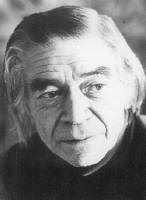Address at the opening reception of the Willi Baumeister Student Exhibition in Wuppertal on March 1, 1969. Erich Fuchs (1916 - 1990) was himself on the Stuttgart Academy faculty between 1949 and 1958. He attended Baumeister's class from 1946 to 1947.
Twenty years ago a Baumeister student exhibition took place in Wuppertal because Willi Baumeister did not succeed in receiving an exhibition for his students in Stuttgart. Today is the opening of the second Baumeister student exhibition, likewise here in Wuppertal. This exhibition should finally, 15 years after Willi Baumeister's death, refer very clearly to the performance and the results of his school. Willi Baumeister's influence and his activity in the postwar years, in the forties and fifties, are so important and stand out like the Bauhaus in the 1920s. The current exhibition is through the size of the exhibition space and the number of participants, there are 48, the first actual report and overview of a school that once was much discussed and contested. In 1946 the Stuttgart Academy was opened by the Cultural Ministry. What was this academy like?
At the time we had the great opportunity to call back the degenerate, the persecuted; this would have been a real response to the Hitler period, but it turned out differently. Was it stupidity or intent - stupidity because the cultural minister perhaps regarded the development abroad and the development in Germany before the Hitler period as degeneration - or was it intentional? Was the modern only to be tolerated in order to be - like an unusable freight car - uncoupled at any time?
Willi Baumeister was isolated within the academy - he was exposed to continual attacks - students from other classes who wanted to attend Baumeister's were threatened by their professors with critique refusal. All Willi Baumeister's encouragement and suggestions to organize the Stuttgart Academy in a contemporary artistic total-structure were turned down with an incomprehensible vehemence. But through him the Stuttgart Academy was considered the most modern school in Germany. (fn 1: In 1947 a cycle of modern art was shown by Dr. Domnick in Stuttgart, in which Baumeister stood out as an exemplar of German modern painting. In 1948 at the Paris Salon des Realités Nouvelles [Salon of New Realities], Willi Baumeister represented the pinnacle of German nonrepresentational painters. His works made the Herbert Herrmann gallery known. Through Baumeister Stuttgart became a reservoir of contemporary art. His studio overflowed with visitors from all over the world. His book The Unknown in Art was published.)
His adversaries at the academy were of the opinion that a teacher should know what art is. Willi Baumeister's view was that:
A good painter is a good pedagogue - a student perceives better with the eye than through the ear. What art is, I do not know; I sense it sometimes, that's why I work. What we call art, is a moment in which we grow beyond ourselves, it is the unique, that which can only happen or be made now, there are no repeats, it is only possible now, it is the moment where we have penetrated to something great - we have to prepare ourselves for this moment. The term art-painter is a conceit - when we paint, we do not know whether it will result in art ...
He said: you cannot discuss with pedagogues, since they are always right. His goal was that the student acquire a foundation -
To acquire a foundation requires time, in this time it will be decided whether the student has it in him to become a painter, if not, he at least has a basis on which he can build in other areas - we don't paint pictures - we study.
Willi Baumeister's teaching was set up on a broad basis. The student was to remain [working] on the sketch as long a possible and continually correct himself. Baumeister might humorously add - don't cheat. You're not fooling me, just yourself.
Baumeister's class grew very quickly. Willi Baumeister's wish to have his own preliminary class was turned down. Whereas the authorities, the Ministry and the Senate stuck to their old ideas, just a few years after the war, industry began to change its opinion about modern art, and corrected it. The influence of Willi Baumeister's school made itself felt and began to assert itself. Industry endeavored, in the form of competitions and commissions, to take on new impulses. (fn. 2: In 1949 there was a collective [sic] exhibition of Willi Baumeister works in Paris at the Galerie Bucher. In 1950 Willi Baumeister defended modern art against [Wilhelm] Hausenstein and [Hans] Sedlmayr. In the same year at a gathering in Munich, he a statesman called hom an idiot - Le Matin in Paris wrote about it on May 28, 1950.
In 1952 John Anthony Thwaites wrote in the Munich Neue Zeitung:
The modern fields at the Stuttgart Academy are constricted and cannot develop further - the old Bauhaus consisted not just of technicians and architects, it consisted of Klee and Kandinsky, Schlemmer and Feininger. In Stuttgart in contrast, Baumeister is forced into the school's vertical structure.
He added:
[Is it any wonder] that the Stuttgart Academy and the works it exhibits correspond to around 1900 and he asks where this unworldly rigidity comes from?
Willi Baumeister remarked to me at the time:
I will be glad when I get out of here, I have only trouble with the academy; I am happy every time when I am back in my ruins and can paint.
In 1954 on his 65th birthday, there was a group exhibition in the Stuttgart Art Building - Franz Roh called this jubilee show a triumph for nonrepresentational painting. The Ministry and the Senate were glad to finally send off a difficult spirit to the retirement bench. His teaching activity was not extended. His class was dissolved. Willi Baumeister was placed on the casualty list. A few years later the Rector's Office cancelled my teaching contract with the comment that I was too much of an artist. In the last year, on February 13, 1968, the senate wrote to the Stuttgart newspaper with the headline, The Senate Responds, on the occasion of a conflict with the students at the Stuttgart Academy: the senate would incidentally be grateful if someone could draw its attention to artists of Willi Baumeister's caliber.
For months we have been scared stiff by the agitation of the youth. If the youth now dismisses us with a wave of the hand, it is because of the neglect to offer them a path. Old models, recipes, theories stand in contradiction to the living. I have thus shown them the path of a man who tried to forge new possibilities and ways in Stuttgart and failed to realize his ideas on a larger scale because of the state's stupidity. Willi Baumeister said:
We should exert ourselves, so that what we do is good.
On his 80th birthday we thank him for that which we learned from him. The good speaks for itself!
(Typescript, quoted from Kermer 1992, p. 179 ff. )

